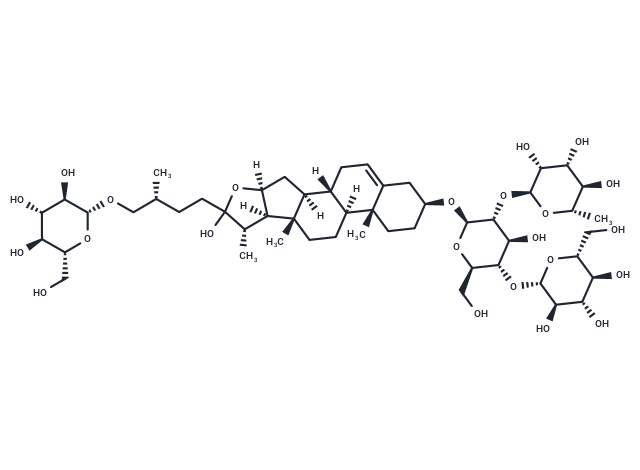Shopping Cart
Remove All Your shopping cart is currently empty
Your shopping cart is currently empty
Protodeltonin may have anti-thrombotic activity by both improving the anticoagulation activity and inhibiting platelet aggregation action. Protodeltonin can inhibit the proliferation of a panel of established human and murine cancer cell lines in vitro.

| Pack Size | Price | USA Warehouse | Global Warehouse | Quantity |
|---|---|---|---|---|
| 100 mg | Inquiry | Backorder | Backorder | |
| 500 mg | Inquiry | Backorder | Backorder |
| Description | Protodeltonin may have anti-thrombotic activity by both improving the anticoagulation activity and inhibiting platelet aggregation action. Protodeltonin can inhibit the proliferation of a panel of established human and murine cancer cell lines in vitro. |
| In vitro | In this study, we isolated and identified seven steroidal saponins from the rhizomes of DZW: diosgenin, trillin, diosgenin diglucoside, deltonin, zingiberensis saponin (ZS), Protodeltonin and parvifloside. Our results showed that these seven compounds inhibited the proliferation of a panel of established human and murine cancer cell lines in vitro. ZS had more cytotoxic effect than the other saponins, even close to doxorubicin on the murine colon carcinoma cell line C26. The proliferation inhibitory effect of ZS was associated with its apoptosis-inducing effect by activation of caspase-3 and caspase-9 and specific proteolytic cleavage of poly (ADP-ribose) polymerase. Exposure of C26 to ZS also resulted in Bax upregulation and Bcl-2 downregulation. |
| Molecular Weight | 1065.21 |
| Formula | C51H84O23 |
| Cas No. | 94992-08-2 |
| Relative Density. | 1.49 g/cm3 (Predicted) |
| Storage | Powder: -20°C for 3 years | In solvent: -80°C for 1 year | Shipping with blue ice/Shipping at ambient temperature. |
| Size | Quantity | Unit Price | Amount | Operation |
|---|

Copyright © 2015-2025 TargetMol Chemicals Inc. All Rights Reserved.